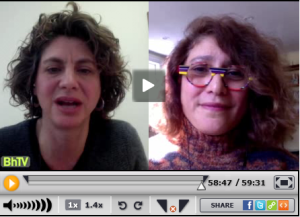Tamar Szabo Gendler (Yale University) and Mahzarin Banaji (Harvard University, Blindspot) discuss the Implicit Association Test, which I highly recommend taking. I took this test for the first time when I was in high school (I discovered that I was incredibly racist, to my embarrassment). They also look at how one can address these implicit biases and discuss how attitudes are and aren’t changing across age groups.  WordPress and bloggingheads.tv appear to be frenemies, so apologies for not being able to fully embed the video. You can either click the image above or go here. This ain’t a short clip, but really good and super important, especially if you are interested in exploring your own implicit biases when it comes to identity locations (psssst: you should be interested!). Also, bloggingheads.tv does that cool thing where you can jump to different parts of the video based on topics discussed.
WordPress and bloggingheads.tv appear to be frenemies, so apologies for not being able to fully embed the video. You can either click the image above or go here. This ain’t a short clip, but really good and super important, especially if you are interested in exploring your own implicit biases when it comes to identity locations (psssst: you should be interested!). Also, bloggingheads.tv does that cool thing where you can jump to different parts of the video based on topics discussed.
After describing the background of the IAT and how it works, Gendler and Banaji discuss the difference between explicit and implicit bias and how implicit bias can impact those around us in quotidian situations. Banaji points out
…You and I are teachers- Who we call on in a classroom, how we might judge a paper- these are all possible instances in which our beliefs about groups of people can enter into our assessments of them.
She’s even had her classes audited where someone counts the instances she calls on students based on gender, and her implicit biases still show. Banaji seems to get a bit frustrated when she discusses how many studies have been done with regards to the IAT and yet there is still resistance. She says,
To me, what’s amazing is that each group refuses to be persuaded that they are capable of making these errors until a study is done with their population of people. And that itself to me is interesting that somehow if I know that lawyers or judges or [inaudible] say “I can’t believe that it could be me. I have to be shown that it is my group that is doing this or I am doing this.
Which makes me wonder when someone will specifically research IAT within the context of drama conservatoire/BFA program faculty and staff. Will that be necessary?
Gendler and Banaji discuss some effective ways to combat implicit biases. One of them is to view images and other forms of media that contain anti-stereotypical messages. Banaji challenges us to take full advantage of our choices:
And of course, the question for person, especially a young person, is, now that the world is at your feet, now that you can listen to Mongolian children making rap music – what will you choose to listen to? What now? – It’s not the three TV stations anymore and the one newspaper at your doorstep…
The conversation closes with this lovely nugget, a point raised by Banaji:
In modern minds like ours, discrimination does not unfold by harming the out-group. But rather, that discrimination has its effects by helping the in-group.
What a concise, clear way to explain privilege. Mmmmmm.
I urge you to take some of the tests over at the IAT website. You might feel really gross afterwards (like I did) but as these two professors discuss, awareness is really the only way to start addressing bias. As ‘self-professed egalitarians,’ we owe it to our students to continually examine our more implicit biases.